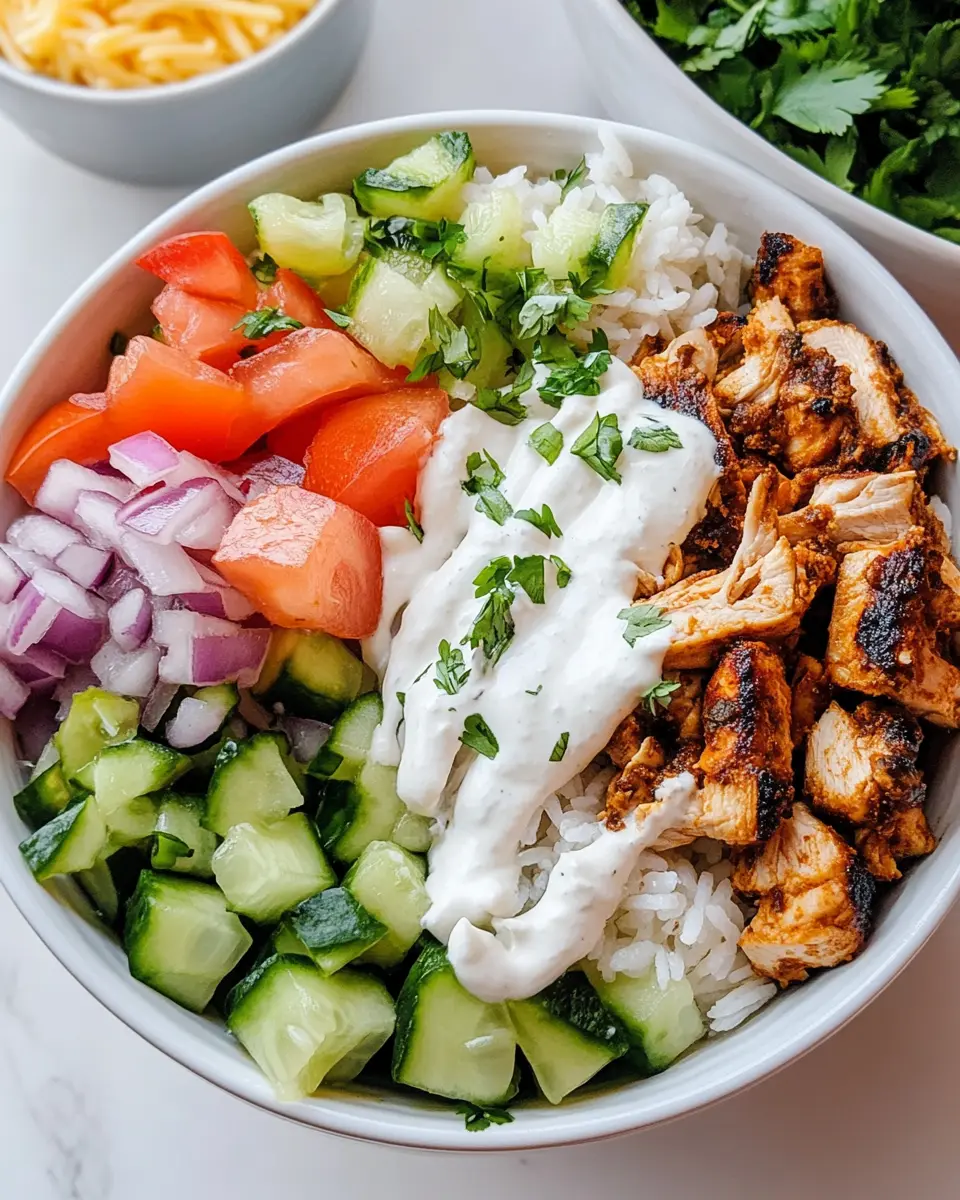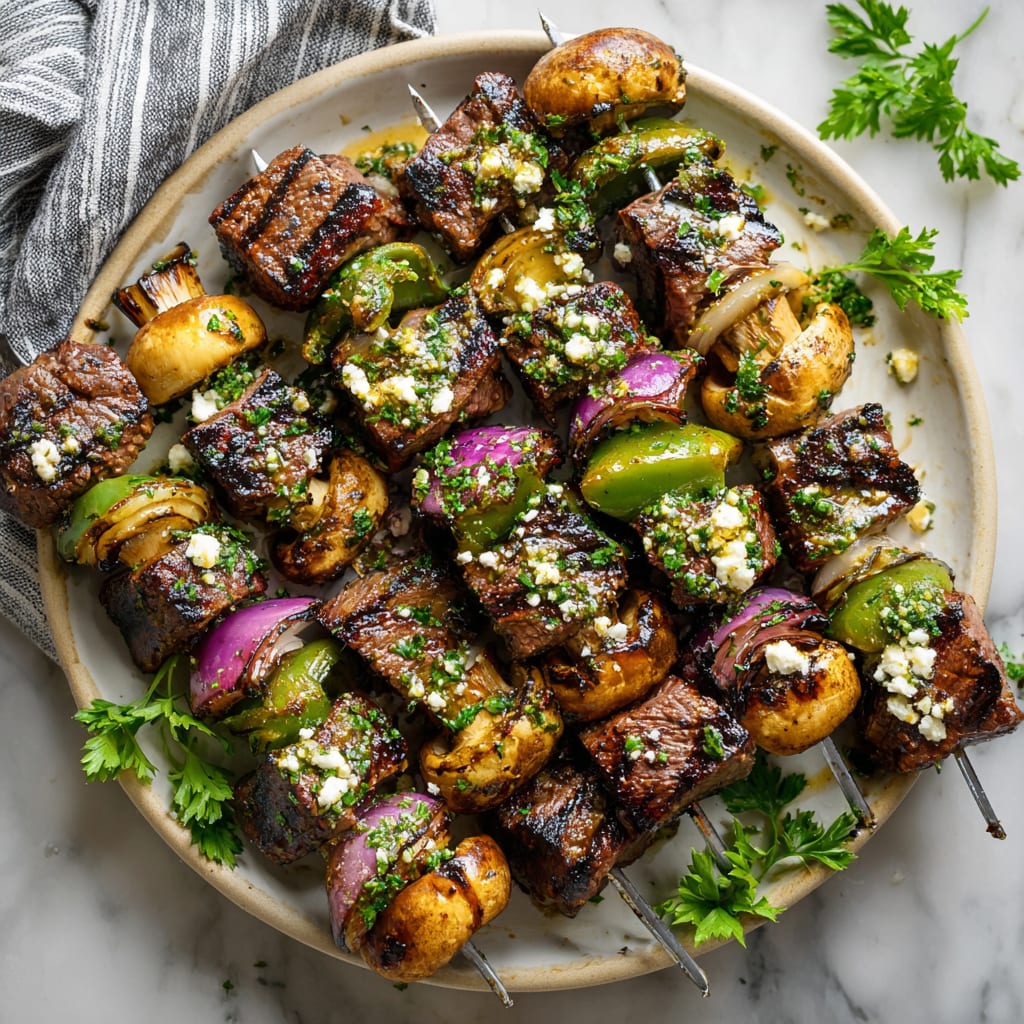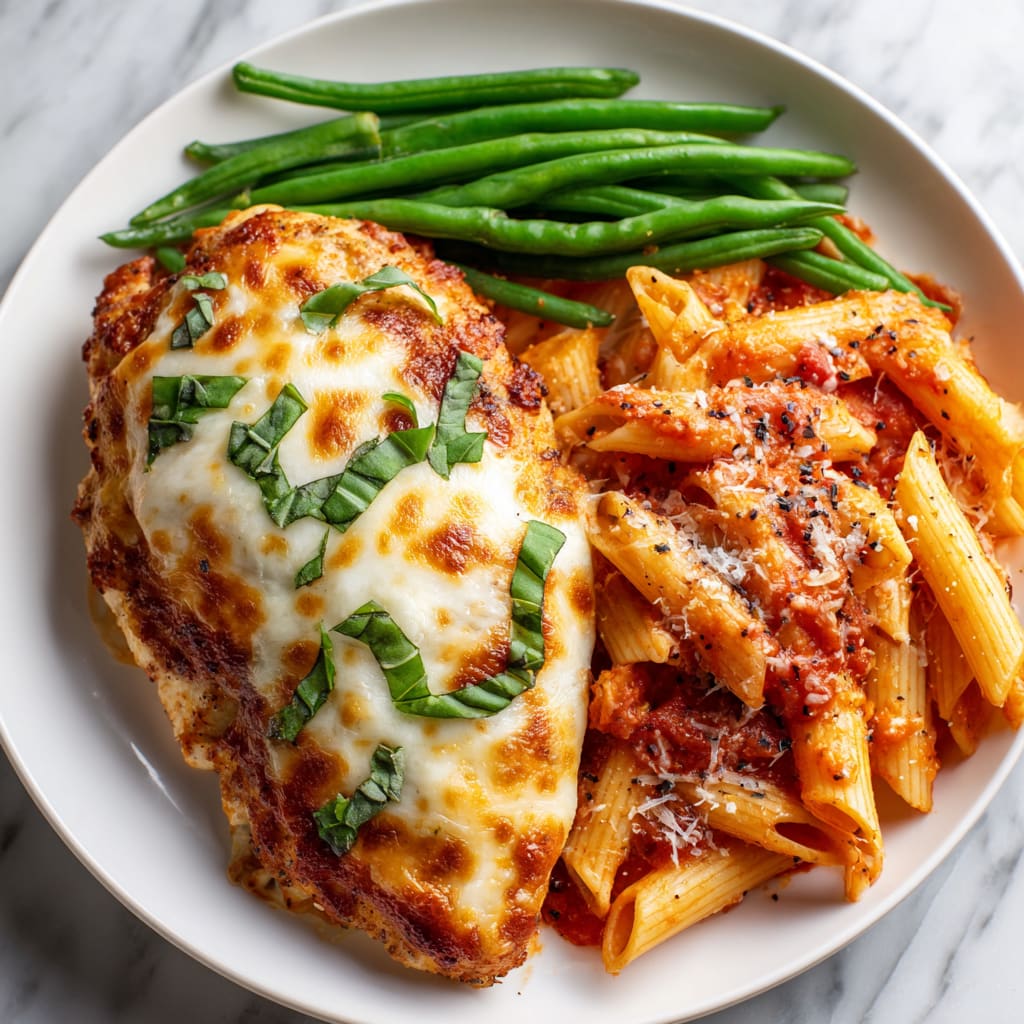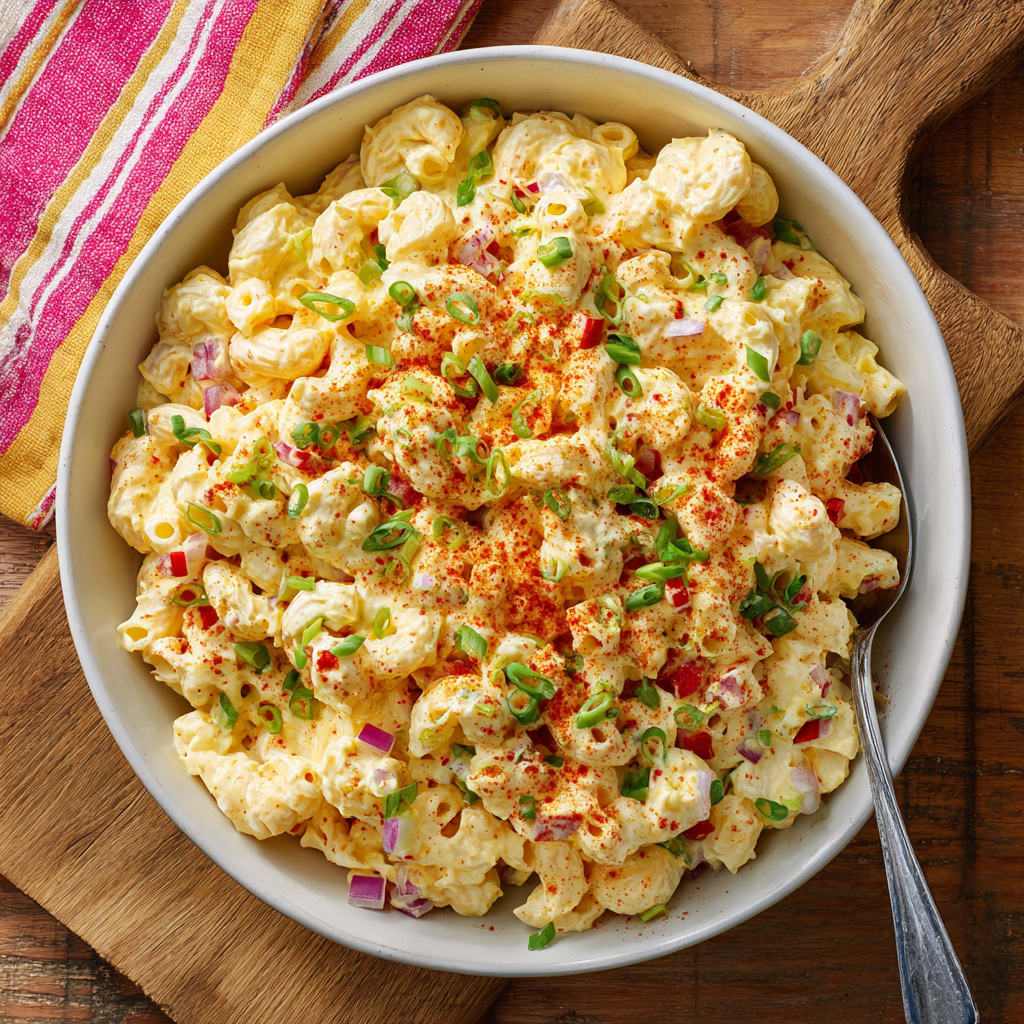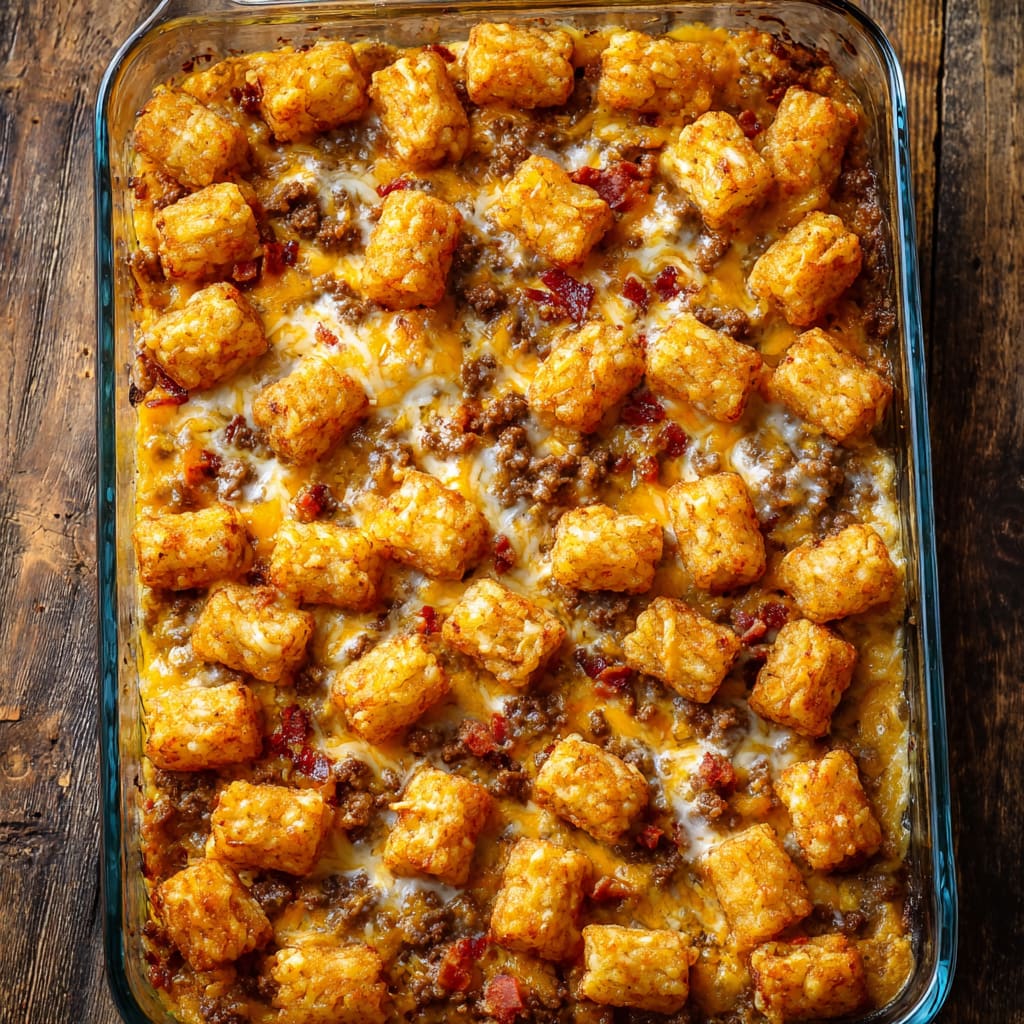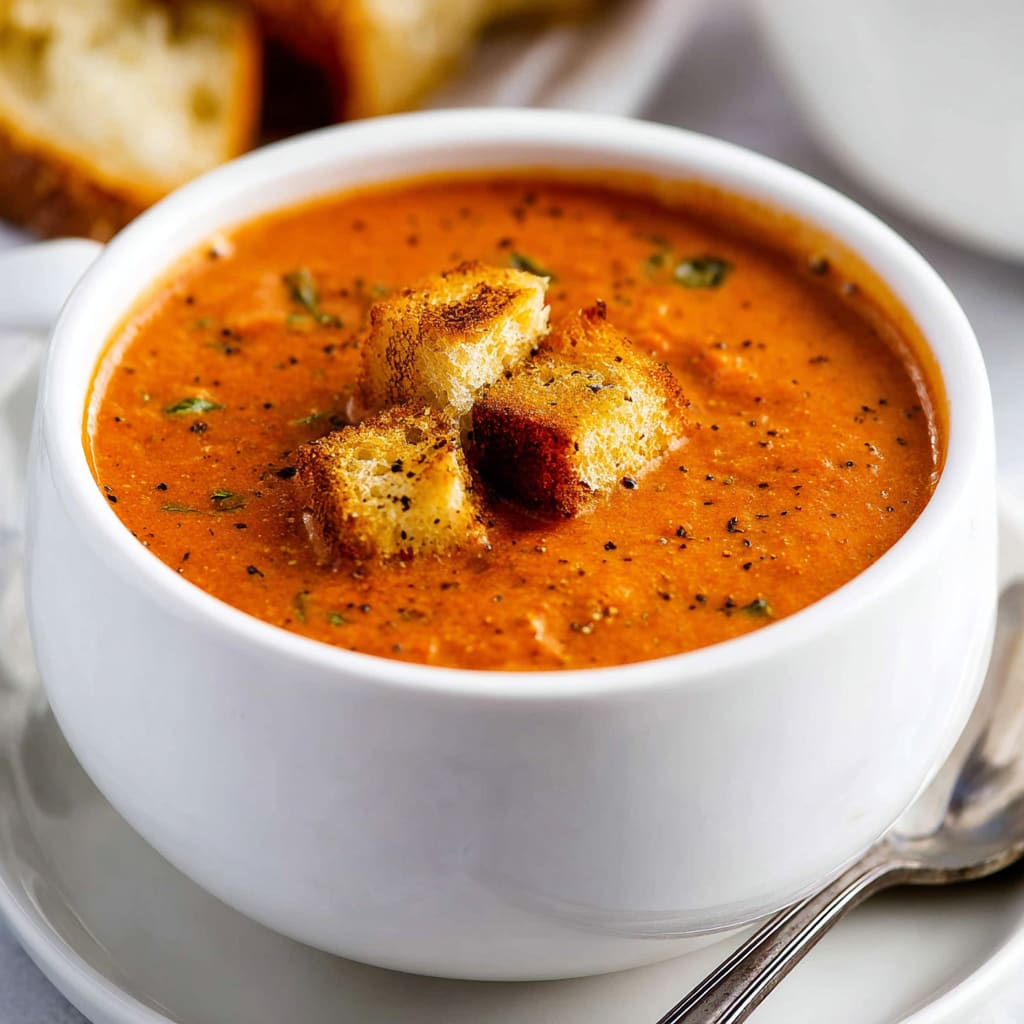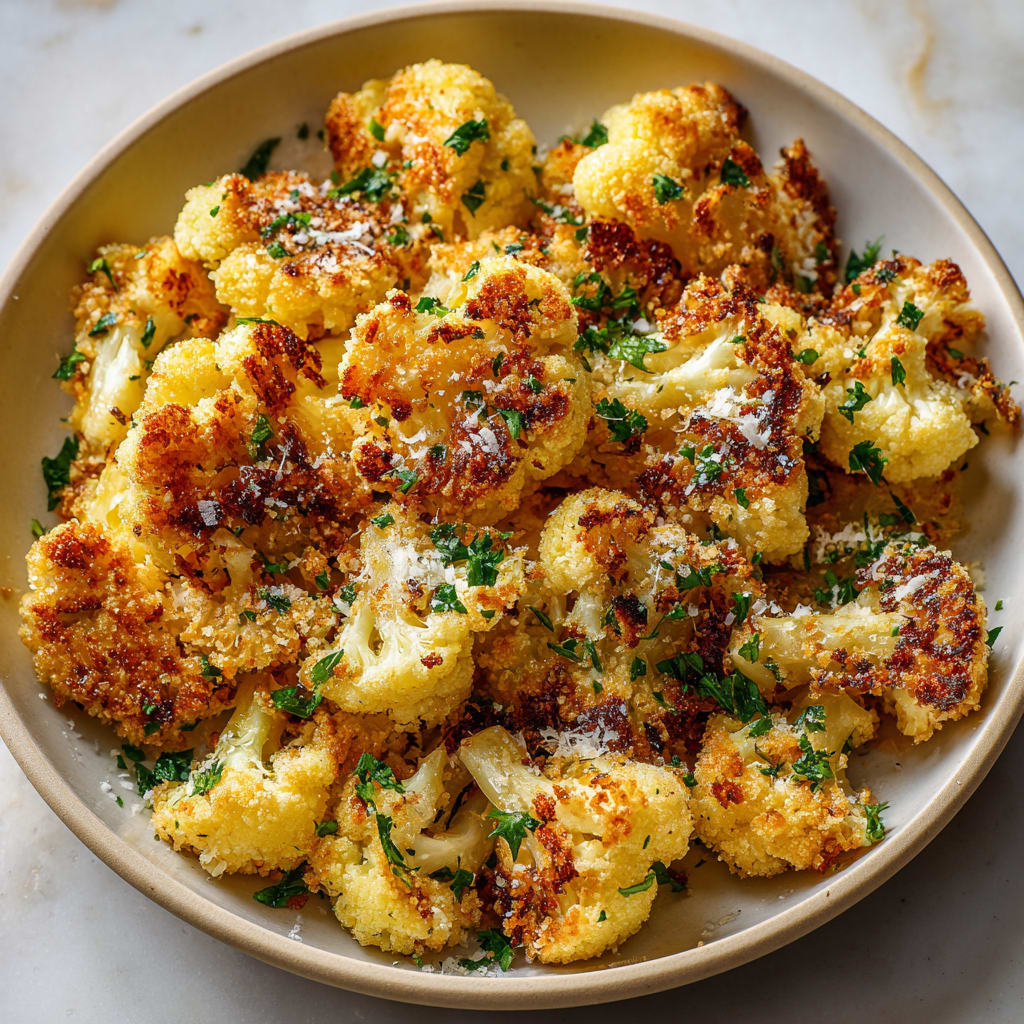Imagine all the vibrant, mouthwatering flavors of a traditional Greek gyro transformed into a convenient, customizable bowl. These Simple Chicken Gyro Bowls deliver the perfect balance of juicy, herb-marinated chicken, tangy tzatziki, fresh vegetables, and fluffy rice – all in one satisfying dish. Whether you’re meal prepping for the week or serving a Mediterranean-inspired dinner, these chicken gyro bowls offer a healthier, deconstructed take on the classic street food favorite. In this guide, you’ll learn how to create restaurant-quality gyro bowls at home with easy-to-follow steps and professional culinary tips.
Why You’ll Love This Recipe
These Simple Chicken Gyro Bowls will quickly become a staple in your meal rotation for countless good reasons. The marinated chicken thighs are incredibly tender and infused with authentic Greek flavors – oregano, garlic, lemon, and olive oil create a deeply satisfying protein that’s both juicy and packed with Mediterranean character. Unlike traditional gyros that require specialized equipment, these bowls deliver all the same flavors with everyday kitchen tools.
The beauty of these bowls lies in their versatility and balance. Each component brings something unique: the warm, seasoned chicken provides richness; the cucumber tomato salad adds freshness and acidity; the tzatziki sauce contributes creamy tanginess; and the rice offers a satisfying foundation that soaks up all those delicious flavors. The contrasting temperatures and textures create a multisensory experience in every bite.
These bowls are also perfect for various dietary needs and preferences. You can easily adjust portions, swap components, or make it vegetarian. For busy professionals and families, the make-ahead potential is invaluable – prep components on Sunday for quick assembly throughout the week. Best of all, you’ll feel good serving a balanced, wholesome meal that doesn’t sacrifice an ounce of flavor or satisfaction.
Recipe Details
The chicken gyro bowl concept represents a modern, deconstructed interpretation of the iconic Greek gyro sandwich. Traditional gyros feature meat (typically lamb, beef, or chicken) cooked on a vertical rotisserie, then thinly sliced and served in pita bread with various toppings. This cooking method dates back centuries in Mediterranean and Middle Eastern cuisines, with the word “gyro” itself coming from the Greek word meaning “turn” or “revolution,” referencing the rotating cooking technique.
Our bowl version transforms this beloved street food into a more accessible home-cooked meal while maintaining authentic flavors. Instead of requiring specialized rotisserie equipment, we marinate chicken thighs in Greek-inspired seasonings before grilling or pan-searing them. This technique still delivers the characteristic flavor profile but with equipment available in any home kitchen.
The bowl format emerged from contemporary food culture’s embrace of customizable, component-based meals. It honors traditional Greek culinary principles – featuring fresh ingredients, herb-forward flavors, olive oil, and yogurt – while adapting them for modern lifestyles. Nutritionists and chefs alike appreciate this format for balancing portion control with satisfying variety. Each bowl component represents an essential aspect of Mediterranean cuisine: protein, vegetables, sauce, and grain, arranged in a visually appealing, convenient format perfect for today’s eat-anywhere lifestyle.
Nutritional Information
These Simple Chicken Gyro Bowls offer an impressive nutritional profile, striking an excellent balance between satisfaction and nourishment. Each serving (approximately 1¾ cups) provides around 425-475 calories, depending on your specific ingredients and portions. The macronutrient breakdown includes approximately 35g of lean protein primarily from the chicken thighs, which supports muscle maintenance and promotes satiety. The bowl contains roughly 45g of carbohydrates, mostly from the whole grain rice and vegetables, providing sustained energy rather than blood sugar spikes.
The healthy fat content (about 15-18g) comes primarily from olive oil, a monounsaturated fat associated with heart health and reduced inflammation. Unlike many restaurant bowls, this homemade version allows you to control sodium levels, with each bowl containing approximately 550-650mg of sodium when prepared as directed.
These bowls shine in their micronutrient content. The chicken provides significant B vitamins for energy metabolism, while the colorful vegetables deliver vitamins A and C for immune support and antioxidant protection. The cucumber-tomato salad contributes potassium, folate, and vitamin K, supporting cardiovascular and bone health. Additionally, the yogurt-based tzatziki offers calcium and probiotics that support digestive health and gut microbiome balance.
For those monitoring specific nutritional concerns, these bowls are relatively low in saturated fat (approximately 3-4g per serving) and contain no artificial additives or preservatives. They’re also rich in dietary fiber (around 5-7g), supporting digestive health and prolonged satiety. While not officially labeled as a “low-carb” meal, reducing the rice portion and increasing vegetables can easily adapt this recipe for lower-carbohydrate dietary preferences.
Ingredients
For the Chicken Marinade (serves 4):
- 1½ pounds (680g) boneless, skinless chicken thighs – They provide more flavor and moisture than breast meat, though breasts can be substituted for a leaner option
- 3 tablespoons (45ml) extra virgin olive oil – Select a good quality oil for its fruity, peppery notes
- 2 tablespoons (30ml) fresh lemon juice – Approximately one medium lemon; bottled juice works in a pinch but lacks the bright flavor
- 4 garlic cloves, minced (about 2 teaspoons) – Fresh provides the best aromatic quality
- 2 teaspoons dried oregano – Greek oregano preferred for its more intense, earthy flavor
- 1 teaspoon dried thyme – Adds subtle floral notes that complement the oregano
- 1 teaspoon ground coriander – Contributes a citrusy background note
- 1 teaspoon kosher salt – Diamond Crystal brand recommended; use half if using table salt
- ½ teaspoon freshly ground black pepper – Freshly ground provides better aroma and flavor
For the Tzatziki Sauce:
- 1 cup (240g) plain Greek yogurt (full-fat preferred) – Provides richness and tangy flavor
- ½ English cucumber, finely grated (about ½ cup) – Seedless varieties prevent excess moisture
- 1 tablespoon (15ml) extra virgin olive oil – Adds smoothness and flavor complexity
- 1 tablespoon (15ml) fresh lemon juice – Brightens the sauce with acidity
- 1 garlic clove, finely minced – Provides subtle bite that mellows as the sauce rests
- 2 tablespoons fresh dill, chopped – Traditional herb that adds distinctive flavor; mint can be substituted
- ½ teaspoon kosher salt – Enhances all flavors
- ¼ teaspoon black pepper – Adds subtle warmth
Additional Bowl Components:
- 2 cups (370g) cooked long-grain rice – Basmati or jasmine rice recommended for aromatic quality
- 1 English cucumber, diced – Offers refreshing crunch and hydration
- 2 cups (300g) cherry tomatoes, halved – Sweet-acidic balance that brightens the bowl
- ½ red onion, thinly sliced – Adds pungency and color contrast
- ½ cup (75g) kalamata olives, pitted and halved – Provides briny, meaty notes
- 4 ounces (115g) feta cheese, crumbled – Adds creamy-tangy richness; authentic Greek feta preferred
- 2 tablespoons fresh parsley, chopped – Final herbaceous lift and visual appeal
Equipment Needed
Creating perfect Simple Chicken Gyro Bowls requires minimal yet specific equipment to ensure optimal texture and flavor development. The cornerstone tool is a good-quality heavy skillet – preferably cast iron or a heavy-bottomed stainless steel pan measuring 10-12 inches in diameter. This type of pan distributes heat evenly and maintains high temperatures necessary for achieving that coveted caramelization on the chicken without burning the spices. The weight and heat retention properties of cast iron make it particularly ideal, creating a beautiful sear that locks in moisture.
For the marination process, you’ll need a non-reactive bowl or container, preferably glass or food-grade plastic, with a tight-fitting lid. Glass containers won’t absorb flavors or stain from the marinade ingredients and allow you to visually monitor the marination process. A gallon-sized resealable plastic bag can serve as an excellent alternative, allowing the marinade to completely surround the chicken while taking up minimal refrigerator space.
The tzatziki preparation requires specific tools to achieve its characteristic texture. A box grater with small to medium holes is essential for properly grating the cucumber – the fine texture is crucial for incorporating it smoothly into the yogurt. You’ll also need cheesecloth or a clean kitchen towel for squeezing excess moisture from the grated cucumber, preventing a watery sauce. For mincing garlic and herbs, a sharp chef’s knife and cutting board are indispensable – wooden cutting boards are preferable for the herbs as they won’t dull your knife as quickly as plastic or glass surfaces.
Additional helpful equipment includes measuring cups and spoons for precise ingredient quantities, a reliable kitchen timer to prevent overcooking the chicken, and individual serving bowls that are wide enough (at least 8 inches in diameter) and deep enough (2-3 inches) to accommodate all components while allowing for easy mixing.
Pro Tips For Success
Achieving restaurant-quality chicken gyro bowls at home hinges on several critical techniques that professional chefs rely on. First, the marinade timing is crucial – while 30 minutes will impart some flavor, allowing the chicken to marinate for at least 4 hours (ideally overnight) creates significantly more developed flavor penetration. The lemon juice and yogurt in the marinade contain enzymes that tenderize the meat fibers, resulting in exceptionally juicy chicken. For maximum flavor absorption, score the chicken thighs with shallow cuts before marinating.
Temperature management is another essential factor often overlooked. Always bring marinated chicken to room temperature (about 30 minutes on the counter) before cooking. This ensures even cooking and better caramelization of the exterior. When cooking, resist the urge to constantly move the chicken; allow it to develop a proper sear by leaving it undisturbed for at least 4-5 minutes per side. Use a meat thermometer to ensure chicken reaches 165°F (74°C) at its thickest point without overcooking.
The tzatziki sauce benefits tremendously from advance preparation – making it 4-24 hours ahead allows flavors to meld and develop complexity. The most common mistake is watery tzatziki; prevent this by thoroughly draining the grated cucumber. After grating, place it in a clean kitchen towel and squeeze aggressively to remove excess moisture – you’ll be surprised how much liquid is extracted. For optimal texture, use whole milk Greek yogurt rather than non-fat versions, which can become watery when mixed with other ingredients.
Component assembly strategy impacts both presentation and eating experience. Build each bowl with intention by placing rice at the base (slightly off-center), arranging chicken and vegetables in distinct sections rather than mixing everything together. This allows the diner to experience components individually or combined as desired. For visual appeal and flavor variation, garnish with additional fresh herbs (mint, parsley, dill) just before serving, and provide lemon wedges for diners to add brightness according to their preference.
Temperature contrast is the secret to exceptional bowls – serve the chicken hot, the rice warm, and the cucumber-tomato mixture and tzatziki cold. This multi-temperature experience creates dynamic flavor perception and elevates the entire dish.
Instructions
For the Chicken:
- Begin by preparing the marinade. In a medium mixing bowl, combine the olive oil, lemon juice, minced garlic, dried oregano, dried thyme, ground coriander, kosher salt, and black pepper. Whisk thoroughly until all ingredients are well incorporated and the mixture becomes slightly emulsified, about 30 seconds. The marinade should appear slightly cloudy rather than separated.
- Trim any excess fat from the chicken thighs, then place them in a gallon-sized ziplock bag or shallow dish. Pour the marinade over the chicken, ensuring each piece is thoroughly coated. Seal the bag, removing as much air as possible, or cover the dish tightly with plastic wrap. Gently massage the marinade into the chicken through the bag. Refrigerate for at least 2 hours, ideally 4-8 hours for maximum flavor penetration. For best results, turn the chicken halfway through the marination time.
- Thirty minutes before cooking, remove the chicken from the refrigerator to allow it to come to room temperature, which ensures more even cooking. Heat a large cast-iron skillet or heavy-bottomed pan over medium-high heat until it’s hot enough that water droplets sizzle and evaporate immediately upon contact.
- Remove the chicken from the marinade, allowing excess liquid to drip off. Discard the remaining marinade. Place the chicken thighs in the hot skillet, being careful not to overcrowd the pan (work in batches if necessary). Cook undisturbed for 5-6 minutes until deeply golden and caramelized on the first side.
- Flip the chicken and continue cooking for another 4-5 minutes until the internal temperature reaches 165°F (74°C) at the thickest part when tested with a meat thermometer. The chicken should have a beautiful golden-brown sear and release easily from the pan. Transfer to a cutting board and let rest for 5 minutes before slicing against the grain into ½-inch strips. This resting period allows juices to redistribute, ensuring moisture retention.
For the Tzatziki Sauce:
- While the chicken marinates, prepare the tzatziki sauce. Start by grating the cucumber using the medium holes of a box grater. Place the grated cucumber in a clean kitchen towel or several layers of cheesecloth, gather the edges, and squeeze firmly over a sink to remove as much liquid as possible. This crucial step prevents watery tzatziki.
- In a medium bowl, combine the strained cucumber with Greek yogurt, olive oil, lemon juice, minced garlic, chopped dill, salt, and pepper. Stir thoroughly until well combined and smooth. Cover and refrigerate for at least 30 minutes, preferably 2 hours, to allow flavors to meld.
Bowl Assembly:
- Prepare the vegetable components by combining diced cucumber, halved cherry tomatoes, and thinly sliced red onion in a bowl. Drizzle with a small amount of olive oil, a squeeze of lemon juice, and a pinch of salt. Toss gently to combine.
- To assemble each bowl, start with ½ cup of warm cooked rice as the base. Arrange sliced chicken over one section of the rice. Add a generous portion of the cucumber-tomato mixture alongside the chicken.
- Place a dollop (about 2-3 tablespoons) of tzatziki sauce in another section of the bowl. Scatter kalamata olive halves and crumbled feta cheese across the bowl. Finish with a sprinkle of freshly chopped parsley and an optional lemon wedge for serving.
- For optimal presentation and flavor experience, serve immediately while the chicken is still warm, creating a delightful temperature contrast with the cool tzatziki and fresh vegetables.
Recipe Variations
The beauty of chicken gyro bowls lies in their adaptability to various dietary preferences and creative interpretations. For a low-carb adaptation, replace the traditional rice base with cauliflower rice – simply pulse cauliflower florets in a food processor until rice-sized, then sauté for 5-7 minutes with a touch of olive oil and seasonings. This substitution reduces carbohydrates by approximately 30g per serving while adding additional fiber and nutrients. Alternatively, a quinoa base provides extra protein and creates a complete protein when combined with the chicken.
For those following plant-based diets, create a delicious vegetarian version by substituting the chicken with roasted chickpeas tossed in the same Greek-inspired marinade, then baked until crispy (400°F for about 25 minutes). Marinated grilled portobello mushrooms also make an excellent meat alternative, offering similar umami satisfaction and substantial texture. In either case, increase the feta portion slightly to maintain protein content, or use a plant-based feta alternative.
Regional inspirations can transform these bowls into unique culinary experiences. For a Turkish twist, incorporate sumac and Aleppo pepper into the chicken marinade, then add a dollop of muhammara (red pepper and walnut spread) alongside the tzatziki. A Moroccan-inspired variation might include cinnamon and cumin in the marinade, with preserved lemon and green olives replacing the kalamatas.
For serving variations, consider a deconstructed gyro wrap option by providing warm pita bread on the side, allowing diners to create their own handheld versions. A family-style presentation works wonderfully for gatherings – arrange all components in separate serving bowls, creating an interactive build-your-own gyro bowl experience that accommodates various preferences and dietary needs.
Seasonal adaptations keep this recipe fresh year-round. In summer, incorporate grilled corn kernels and zucchini into the vegetable mixture; in winter, add roasted butternut squash cubes tossed with the same Greek seasonings as the chicken for a heartier, warming bowl experience.
Storage & Serving Suggestions
For optimal freshness and food safety, properly store the components of your chicken gyro bowls separately rather than as assembled bowls. The cooked, sliced chicken can be refrigerated in an airtight container for up to 3-4 days. To maintain its juiciness when reheating, sprinkle a few drops of water over the chicken before covering with a microwave-safe lid and heating on medium power for 1-2 minutes. Alternatively, reheat in a skillet over medium-low heat with a splash of olive oil to restore some of the original caramelization.
The tzatziki sauce keeps well for up to 5 days when stored in an airtight container in the refrigerator. It may separate slightly; simply stir before using. The cucumber-tomato salad is best consumed within 24-48 hours, as the vegetables will continue to release moisture and lose their crispness. Store it separately from other components and drain any accumulated liquid before serving leftovers.
For make-ahead meal prep, consider preparing double batches of the chicken and tzatziki on Sunday, then storing components in individual containers for quick assembly throughout the week. Cooked rice can be refrigerated for 3-4 days or frozen for up to a month in portioned containers. To revitalize day-old rice, sprinkle with a few drops of water before reheating to restore moisture.
Serving these bowls becomes an art form with thoughtful presentation. Use wide, shallow bowls to showcase the colorful components. For casual entertaining, create a gyro bowl bar where guests can customize their portions. Accompany with warm pita triangles brushed with olive oil and sprinkled with oregano for dipping or scooping.
Beverage pairings elevate the dining experience: a crisp, citrusy Assyrtiko from Santorini perfectly complements the Mediterranean flavors, while a light cucumber-mint water infusion offers a refreshing non-alcoholic option. For a complete meal, start with a simple Greek meze platter featuring marinated olives and pepperoncini, followed by these flavorful bowls and concluding with honey-drizzled Greek yogurt topped with pistachios for a light dessert.
FAQs
Q: Can I use chicken breasts instead of thighs? A: Absolutely. Chicken breasts will work, though they tend to cook more quickly and can dry out easier than thighs. Reduce cooking time by approximately 2 minutes per side and consider tenderizing them slightly with a meat mallet before marinating. For optimal results, monitor internal temperature closely, removing the breasts from heat once they reach 160°F, as they’ll continue cooking to the food-safe 165°F during resting.
Q: How can I make this recipe dairy-free? A: For a dairy-free version, prepare tzatziki using coconut yogurt or a high-quality unsweetened dairy-free yogurt alternative. You may need to add an extra squeeze of lemon juice to replicate Greek yogurt’s tanginess. Replace the feta with a dairy-free alternative or omit it entirely, adding extra kalamata olives for similar salty notes. Another option is including cubed avocado to provide the creamy texture that feta would normally contribute.
Q: Is there a shortcut for busy weeknights? A: Yes! Marinate and cook a large batch of chicken on the weekend, then refrigerate or freeze in portions. Pre-make the tzatziki sauce and store it separately. For extremely quick assembly, use quality store-bought tzatziki and pre-cooked microwaveable rice. Another time-saver is preparing the vegetable mixture without dressing it, then storing it in a paper-towel-lined container to absorb excess moisture, dressing just before serving.
Q: How spicy is this recipe? Can I add more heat? A: As written, this recipe is very mild and family-friendly. To add heat, incorporate ½-1 teaspoon of red pepper flakes into the chicken marinade. Alternatively, serve with Greek-style hot peppers on the side or add a spoonful of harissa paste to the tzatziki for a North African-inspired spicy twist. A sprinkle of Aleppo pepper over the finished bowl offers gentle, complexity-enhancing heat.
Q: Can I grill the chicken instead of pan-cooking? A: Grilling works beautifully for this recipe, adding smoky notes that complement the Mediterranean flavors. Preheat a gas grill to medium-high (around 400°F) or prepare a charcoal grill with a medium-hot zone. Grill chicken thighs for 5-7 minutes per side until they reach 165°F internally. Let them rest before slicing, as you would with pan-cooked chicken.
Q: How do I prevent soggy vegetables in my bowl? A: The key is proper draining and assembly timing. After dicing cucumber, sprinkle lightly with salt and let sit in a colander for 10 minutes to draw out excess moisture, then pat dry with paper towels. For tomatoes, remove seeds and gel before dicing. When meal-prepping, store the vegetable mixture separately, combining it with other components only at serving time. When assembling bowls, place wet components like tzatziki and vegetables away from dry elements like rice to maintain textural integrity.
Conclusion
These Simple Chicken Gyro Bowls represent more than just a convenient meal – they’re a celebration of Mediterranean flavors in a format that fits modern lifestyles perfectly. By deconstructing the classic gyro into a customizable bowl, you’ve gained the ability to enjoy these vibrant flavors any day of the week, without specialized equipment or techniques. The beauty of this dish lies in its balance: tender, herb-infused chicken complemented by cool, crisp vegetables and creamy tzatziki, all anchored by fluffy rice.
As you master this recipe, don’t hesitate to make it your own. Whether you’re adjusting components to suit dietary preferences, experimenting with seasonal ingredients, or preparing components ahead for busy weeknight solutions, these bowls adapt to your needs while maintaining their essential character. The techniques you’ve learned – properly marinating protein, balancing temperature contrasts, and creating complementary textures – will serve you well beyond this specific recipe.
Print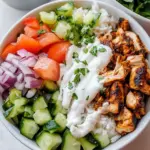
Simple Chicken Gyro Bowls
Description
Transform classic Greek street food into healthy, flavorful Chicken Gyro Bowls with marinated chicken, fresh veggies and homemade tzatziki.
Ingredients
Chicken Marinade
- 1/4 cup plain Greek yogurt, low fat or full fat are best
- 2 tablespoons fresh lemon juice
- 2 cloves garlic, grated
- 2 tablespoon chopped flat leaf parsley
- 1 tablespoon olive oil
- 1 1/2 teaspoons dried oregano
- 1/2 teaspoon smoked paprika
- 1/2 teaspoon ground cumin
- 1/2 teaspoon ground coriander
- Salt and freshly ground black pepper to taste
- 1 1/4 pounds boneless skinless chicken breasts cut into bite sized pieces
Tzatziki sauce
- 1 cup shredded cucumber you can also dice the cucumber
- 1 1/2 cups plain Greek yogurt, low fat or full fat are best
- 2 tablespoons fresh lemon juice
- 1 tablespoon chopped fresh dill
- 1/2 teaspoon grated garlic, 1 teaspoon if you like it extra garlicy
- Salt and freshly ground black pepper to taste
Other Ingredients
- 1 cup quartered cherry tomatoes
- 1 cup diced cucumber
- 1/4 cup diced red onion
- 1/3 cup kalamata olives
- 1/2 cup crumbled feta cheese
- 2 cups cooked brown rice
Instructions
- Combine all the ingredients for the chicken marinade in a bowl and stir together until combined. Add in the cubed chicken and let it marinate for 30 minutes.
- While the chicken marinates make the tzatziki sauce. Stir together all of the ingredients and taste for seasoning. Refrigerate until ready to serve.
- In a large skillet over medium-high heat add enough olive oil to coat the bottom of the pan. Add in the chicken and spread it into a single layer. Let it brown for 3-4 minutes before flipping it over. Continue to cook another 4-5 minutes or until it’s cooked through.
- To assemble the bowls, fill the bowl with rice and then top it with some of the chicken, cucumbers, red onion, tomatoes, kalamata olives, crumbled feta, and tzatziki sauce.

